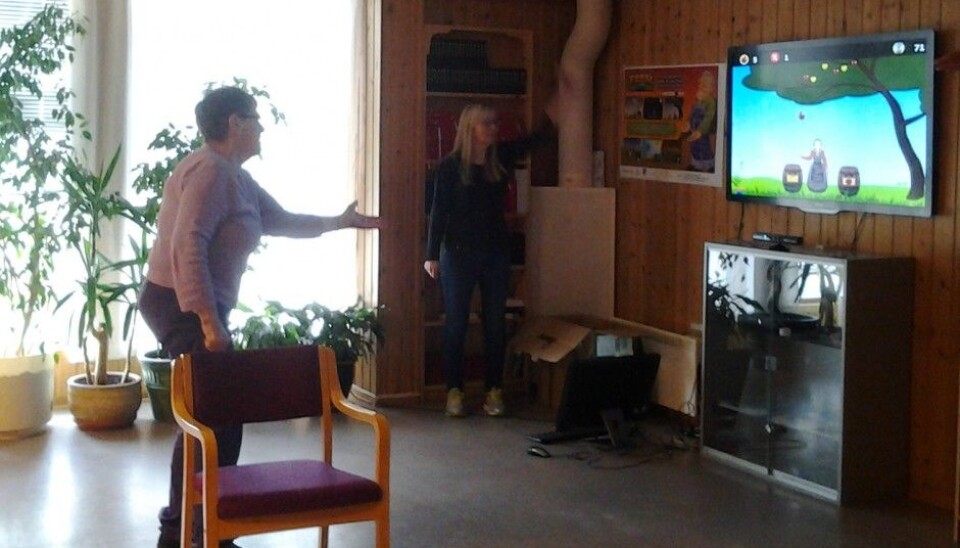An article from Norut - Northern Research Institute

Why seniors should try gaming
Game technology can prevent seniors from falling and improve their balance, strength and coordination. But the games must be designed completely differently than those for young people, a new study shows.
A great grandmother (91) tiptoes in front of a TV screen. She needs to stretch to reach an apple and put it in a basket, but the apples come rapidly. The sound of the apple hitting the basket is too high for sensitive ears. She is unable to keep up with the game and gives up.
“We see that games for seniors must be designed completely differently than those for young people, but the game industry has not fully appreciated this yet,” says Norut Senior Research Scientist Ellen Brox.
She has followed 16 seniors over a three-year period to see how they move when they play exergames. The main objective was to find out what movements, content and game elements work for the elderly. The aim is for them to gain better balance, strength and coordination by playing the games.
Don’t understand seniors
In a recently published article in JMIR Publications, Brox underlines the importance of direct feedback from the participants in the study, who had an average age of above 80 years. The oldest participant was 95. Most of the games are designed by young men, far removed from the target group for this technology.
The young game designers do not understand how much the sound, colour and pace must be adjusted so that the older players will benefit from the games. This became apparent during the study.
One example was that the objective was for players to win a trophy, but the drawing was so detailed that the participants thought it was an egg cup. The game designers needed to change to rougher shapes that are more adapted to an older person’s vision.
“It shows how important it is to involve your actual users, so they can provide feedback on the spot. I’m 61 and even I’m too young,” says Brox.
Low music
The researcher also discovered how important it was to cut out background music when the players received verbal messages, otherwise they could not hear what was said. The sounds that provide feedback and any music must both be pleasant. However, the players did not like games that were completely without sound either because they did not become as involved in the game.
Since people’s colour vision deteriorates as they get older, it is necessary to have clear contrasts and use large, clear text.
“When children play Wii, they like a lot to be happening in the game. However, the seniors grasp exactly what is happening in the middle of the screen at any given time, and they need breaks to see how far they have progressed. They find it frustrating if they lose track but the game just continues,” says Brox.
The participants found other games fun and exciting to try, but the researchers could see they did not always follow the plot. However, they gave the clear feedback if they felt the games were too childish.
“After all, they are adults. After a while, they became very good at expressing their opinions,” says Brox.
Getting in better shape
The research shows that the game industry must take a lot more into account when developing games for the oldest users, for example for use at nursing homes. Although the exercises in the games are recommended by physiotherapists, there are many things to consider, such as avoiding serious injuries.
“The participants tried a commercial game where players needed to jump to start the game. But this game was intended for younger users, so we had to jump for them to start the game. Safety is of the utmost importance and we don’t want them to fracture their hip. Consequently, we always had a chair next to the game.”
Seniors derive a major reward from gaming. They get into better shape, because when things happen in the game, they need to move their arms and legs. A camera below the screen detects movement in all the joints of the body, so it is not possible to cheat one’s way to success.
“The games really challenge their strength and balance,” says Brox.
The hope is that seniors will be able to live longer in their own homes by exercising in this way. A nursing home in Alta is also testing out the games in daily life.
Small market
However, the greatest challenge is commercialising the games, since the market is so small and demanding.
“The technology is constantly changing, so we see that game developers need to have big muscles to enter this field. We are familiar with companies wishing to develop games for seniors, such as Plus Point in Tromsø, but they are reliant on assistance with funding and sales. This has proven to be difficult, which often means small game development companies don’t dare to take the risk,” says the researcher.
Meanwhile, the 91-year-old is trying to put the apple in the basket while other apples continue to fall. However, the purpose of this game is not to put as many apples as possible in the basket in the shortest possible time. The most important aspect is the movement, so she can increase the flexibility of her arms so it will not be as serious if she falls. Consequently, stretching to reach the first apple that falls may be enough to achieve this.
Norut carried out the study in collaboration with the game developer Plus Point, while user testing was coordinated by the Tromsøysund parish.
































